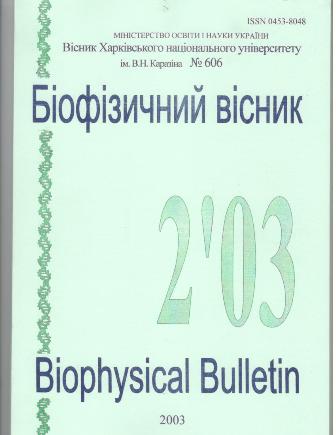Спрощена модель ієрархічного фолдінгу білків з самоузгодженою енергією зв’язку
Анотація
В роботі розглядається спрощена модель фолдінгу білку, в якій білок розглядається як гомо полімер, що компактизується ієрархічним чином. Вважається, що спочатку утворюються локальні кластери мономерів (кластери першого порядку), які потім об’єднуються у кластери вищих порядків. Утворення кластерів вищого порядку вважається набагато повільнішим за динаміку кластерів, нижчого порядку і розглядається у адіабатичному наближенні. При утворенні кластерів в їх структурі “заморожуються” ступені вільності окремих мономерів, що веде до ефективного стискання доступного конфірмаційного простору ланцюгу і ефективного мінімуму на гіперповерхні вільної енергії, який є нативним станом ланцюгу. Енергія зв’язку мономерів у кластерах вважається залежною від крупно масштабної повільної узагальненої координати, яка характеризує ступінь сформованості нативної структури. В свою чергу ця координата залежить від середньої кількості утворених зв’язків, так, що система в цілому стає самоузгодженою. Показано, що така система може мати два дискретні стаціонарні стани – розгорнутий та нативний. Імовірність реалізації цих станів в залежності від температури та концентрації денатуранту у розчині повністю відповідають експериментальним даним.
Завантаження
Посилання
Dobson CM, Sail A, Karplus M. Protein Folding: A Perspective from Theory and Experiment. Angew. Chem. Int. Ed. 1998;37:868-93.
Mirny L, Shakhnovich E. Protein folding theory: from lattice to all-atom models. Annu. Rev. Biophys. Biomol. Struct. 2001;30:361-96.
Yesylevskyy SO, Demchenko AP. Modeling the hierarchical protein folding using clustering Monte-Carlo algorithm. Protein and Peptide Letters. 2001;6:437-42.
Michalet X, Weiss S. Single-molecule spectroscopy and microscopy. C. R. Physique. 2002;3:619-44.
Yesylevskyy SO, Demchenko AP. Towards realistic description of collective motions in the lattice protein folding models. J. Biophys. Chem. 2003.
Goushcha AO, Kharkyanen VN, Scott GW, Holzwarth AR. Self-Regulation Phenomena in Baacterial Reaction Centers. I. Gneral Theory. Byophys. J. 2000;79:1237-52.
Yesylevskyy SO, Kharkyanen VN. Hierarchy of motions and quasi-particles in the simplified model of potassium channel selectivity filter. J. Biological Physics. 2003.
Demchenko AP, Ustinov AA, Kharkianen VN. Analiticheskaia teoriia ligand-indutcirovannykh konformatcionnykh perekhodov v belkakh. Biofizicheskii vestnik. 2001;1(8):7-17. (in Russian)
Автори, які публікуються у цьому журналі, погоджуються з наступними умовами:
- Автори залишають за собою право на авторство своєї роботи та передають журналу право першої публікації цієї роботи на умовах ліцензії Creative Commons Attribution License, котра дозволяє іншим особам вільно розповсюджувати опубліковану роботу з обов'язковим посиланням на авторів оригінальної роботи та першу публікацію роботи у цьому журналі.
- Автори мають право укладати самостійні додаткові угоди щодо неексклюзивного розповсюдження роботи у тому вигляді, в якому вона була опублікована цим журналом (наприклад, розміщувати роботу в електронному сховищі установи або публікувати у складі монографії), за умови збереження посилання на першу публікацію роботи у цьому журналі.
- Політика журналу дозволяє і заохочує розміщення авторами в мережі Інтернет (наприклад, у сховищах установ або на особистих веб-сайтах) рукопису роботи, як до подання цього рукопису до редакції, так і під час його редакційного опрацювання, оскільки це сприяє виникненню продуктивної наукової дискусії та позитивно позначається на оперативності та динаміці цитування опублікованої роботи (див. The Effect of Open Access).





